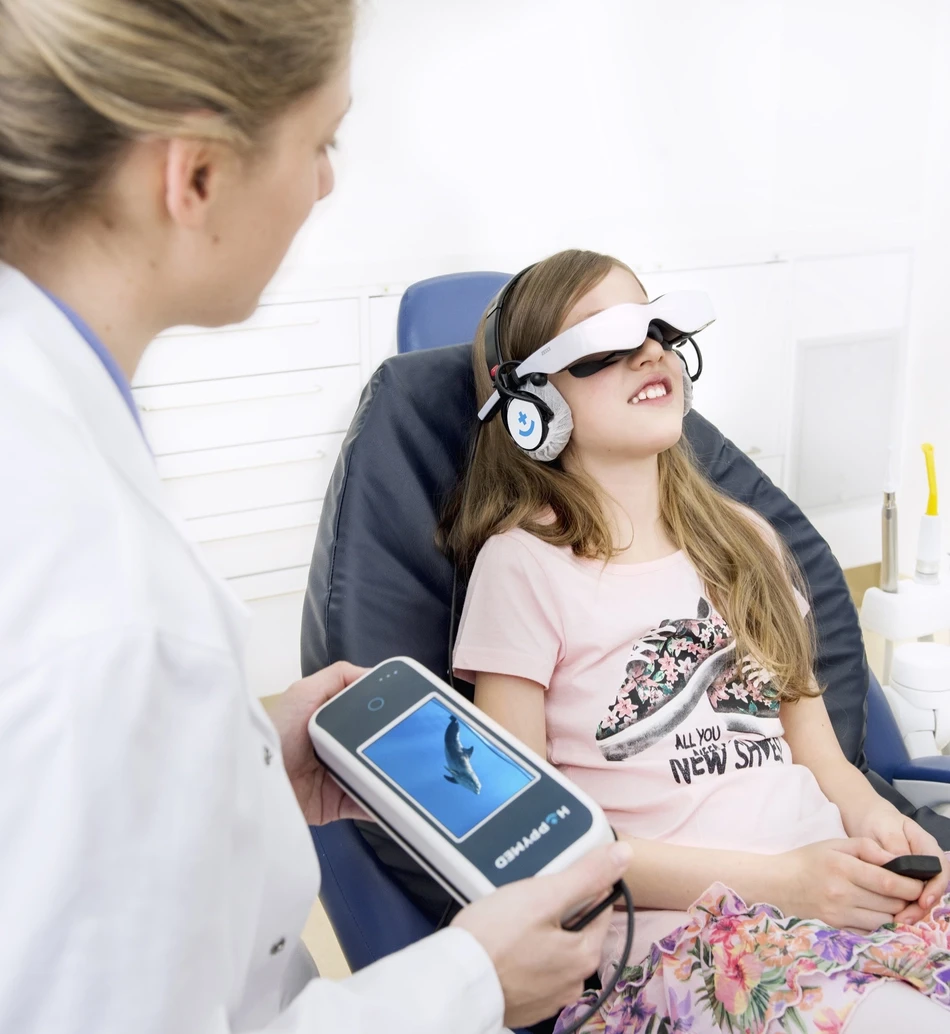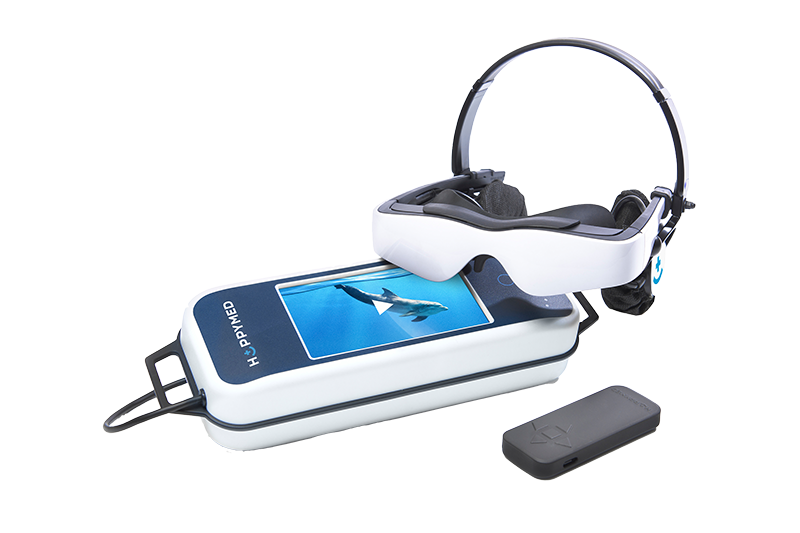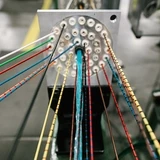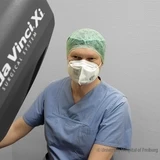Singing through the pain

Is it possible to relieve the stress of a surgical procedure without any drugs? It is now thanks to an appropriately named solution: HappyMed.
Its creator explains how his start-up has helped more than 100,000 patients, with surprising results.
Philipp Albrecht, reclined in his dentist’s chair, averting his eyes from the doctor’s gaze, was staring at the white ceiling, as usual. This was back in 2014 when, at the age of 25, he suddenly realised that he’d been staring at the same dull white ceiling for over two decades, every time he had been at the dentist. “Why is that so?” asks the man who describes himself as a technologist who started programming at age 14. ”Why has this experience never been improved? What can I do about it?”
The young man discarded the idea of a screen attached to the ceiling immediately – the dentist’s head would always get in the way. How about video glasses? They already exist, but the world of healthcare does not tend to use them. There must be a reason for this and obviously a market for a custom-developed solution.
Two years of market research resulted in a prototype (a wooden case held together by duct tape), developed from scratch. Albrecht presented it to around 70 hospitals (considered to be a more relevant market than dentists). A lot of feedback was gathered on the device and the operating system, both of which were developed in-house.
HappyMed was finally launched in mid-2017. Version 2 (with an optimised operating system, a higher screen resolution, improved batteries and new functionalities) followed a year later. The solution, in the form of a monthly subscription service (approximately EUR 200 per month) has found its market. Albrecht mentions several hundreds of hospitals who are subscribers, as well as over 100,000 patient-users. “HappyMed has been recognized and is becoming increasingly well known. We now have positive momentum.” All this sounds like an encouraging launch.
HappyMed appears to be like any other video glasses, like a virtual reality headset, only lighter. Two HD screens with Zeiss lenses, surround sound headphones and a small media centre including a screen and a minimalist remote controller. With just a few clicks, you can immerse yourself in films, concerts, documentaries or meditation sessions.
Does it work? Every parent who has ever put a child in front of a screen to calm them down or to keep them busy during a long journey knows it: the child’s attention is captivated, completely cut off from the outside world. It turns out that this method of distraction and relaxation can work just as well in the context of a medical procedure.
“HappyMed is beneficial before, during and after an intervention”, highlights Albrecht. Patients are less stressed. They breathe more slowly, their heart beats more calmly, and pain perception decreases. During the operation, the beeps and audible alerts are muted, people in masks and all the horrible tools are out of sight. The whole intervention moves into the background. Therefore, patients need less tranquillisers and painkillers. “In one third of the cases, HappyMed is able to replace medical sedation” estimates Albrecht.
Similarly, patients are able to replace general anaesthesia with more local pain relief instead. “Moreover, HappyMed has no side effects!” he adds with a smile.
All of this contributes to reducing surgical risks, as well as the duration of interventions and wake-up times. It also improves recovery and reduces the duration of the patient’s hospital stay. Its effects have been confirmed by studies on positive audiovisual distraction, quoted on the startup’s website. They have also been supported by HappyMed own study conducted over two years and soon-to-be published in medical reviews.
Divert attention in order to diminish the perception of a painful reality… isn’t that an obvious idea? “It was, but its implementation wasn’t!” replies Albrecht. “To be adopted in the medical field, a number of challenges had to be solved and this is what we have succeeded in.”
The first challenge was the same as for all medical device manufacturers: to create a technology which complies with the extensive safety and hygiene certifications. This influences the choice of materials (which have to resist repeated cleaning with alcohol), wave emissions (electromagnetic field, WiFi, Bluetooth, radio, processor frequency…), but also manufacturing processes or the company’s operations.

“On the other hand, HappyMed had to be as simple as possible, so that all, from young children to elderly people, the healthcare team and the patients are able to use it. Any difficulty would result in rejection by the user, who has much greater worries to handle at the same time.” All aspects have been carefully considered. For example, instead of a single switch, for muting the device while talking to the patient, there are two, on both sides of the headset to provide for easy access.
Albrecht concluded very quickly that efficient hardware, along with a user-friendly interface would not be sufficient. If he wanted to conquer the market, a major challenge was to be handled: the content.
Content distribution by a hospital is not considered as private, but rather as commercial use. It is subject to special terms and hospitals are not willing to spend time either on negotiating or taking the risk of circumventing them.
HappyMed could not afford to pay an expert lawyer, so Philipp Albrecht himself learnt all about it. “It is complex and it takes a lot of time to get into it” – a slight understatement by the young man, who went off to the Cannes Film Festival to present HappyMed to film producers in search for solutions. He has also contacted Hollywood directly. “Sometimes we had to negotiate for 2 and a half years to get a deal approved. Since the contracts are valid for only 1 or 2 years, you have to do it over and over again.”
Luckily, the catalogue doesn’t have to be extensive, explains Albrecht. There’s no need to compete with Netflix or Amazon. Patients generally use HappyMed for one to three hours and most of them will only rarely get the opportunity to use it again.
For hospitals, the most important thing is that HappyMed makes up the catalogue, They don’t have the time to choose appropriate content.
Contents are automatically updated, videos are downloaded from HappyMed’s servers overnight (via WiFi or cellular). During the day, everything is on the device, nothing is broadcast live, which avoids monopolising the bandwidth and creating radiation.
With its certified hardware and its worry-free content management, “HappyMed is a truly plug-and-play solution” says Albrecht. “That’s what we were aiming for since the very start.”
Ten years ago, Philipp Albrecht left his native Germany to study in Austria. He never went back and it was in Vienna that he founded HappyMed in January 2015. Today the start-up has a staff of a dozen employees and it has been regularly growing in numbers.
The team is currently working on improving their device. They have also been studying the possibility of new content categories, such as “personal development films, for instance, empowering patients with knowledge to help their recovery.” HappyMed are even planning to add another string to their bow by producing their own content. The startup would like to broaden their market beyond Europe and “is open to new investors.”
The young entrepreneur says he is confident and is not afraid of competition. “We are way ahead of them!”
What makes him especially proud today? “Making a difference”, he answers with no hesitation. “Making a difference for people going through hard times.”
In fact, HappyMed is regularly used during cardiac catheter examinations, long chemotherapy sessions, spinal marrow aspiration, orthopaedic operations… Some of those situations – often the worst moments in a person’s life – that we all wish to avoid, absolutely, instinctively. This is exactly what HappyMed help to do, with their distracting, interesting, perhaps even inspiring escape solution.
“We get a lot of nice testimonials from our customers”, say Albrecht. “Some patients start humming in the operating theatre. Some even burst out laughing in the middle of an operation!” The young entrepreneur adds, with a touch of emotion, “This is such a nice thing.”


